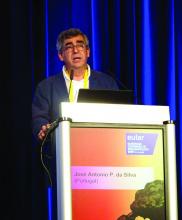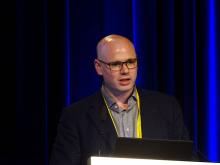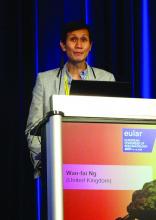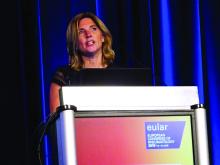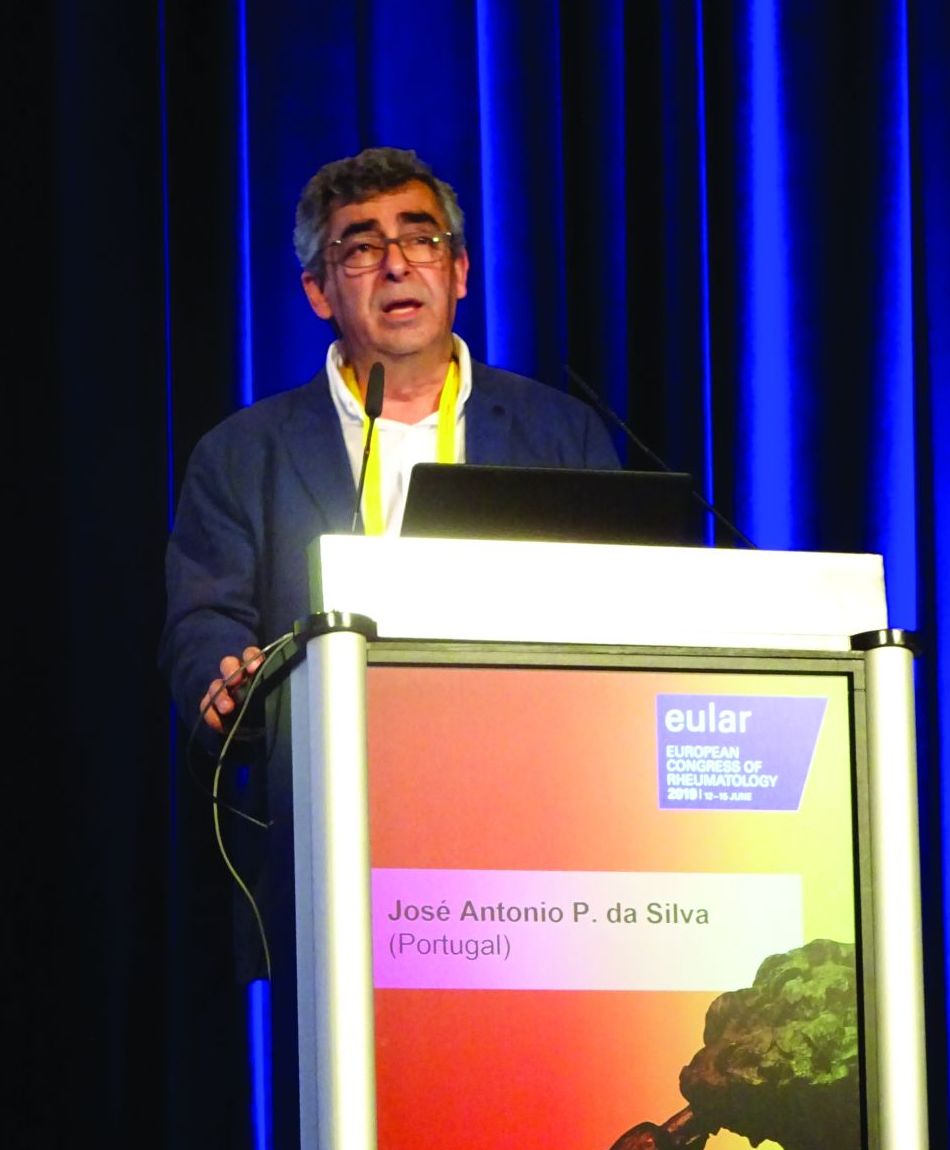User login
MADRID – Fatigue is one of the most frequent features of rheumatoid arthritis, and it needs to be assessed and addressed, several leading rheumatology experts urged at the European Congress of Rheumatology.
“Fatigue is an outcome of outstanding importance for patients with rheumatoid arthritis, and therefore it should be an outcome of outstanding importance for clinicians who take care of these patients,” said José António Pereira da Silva, MD, PhD, a professor of rheumatology at the University of Coimbra (Portugal) during a clinical science session dedicated to the topic.
“Fatigue is described as being significant by as many as 40%-80% of all patients with rheumatoid arthritis, and described as being severe by 41%-49% of these patients according to different studies,” Dr. da Silva said.
“The impact upon the quality of life from the patients’ perspective is quite varied but always rather important, if not ‘dramatic,’ ” Dr. da Silva said. Fatigue needs to be part of treatment targets alongside disease activity and thus regularly measured, he added.
The problem of fatigue
The problem, however, is that fatigue is such a complex construct, observed James Galloway, MBChB, PhD, of the Centre for Rheumatic Diseases at King’s College London. “It’s definitely multifactorial in origin; it’s a combination of inflammatory disease, psychosocial situations, and comorbidity.”
Moreover, said Dr. Galloway, “what people describe as fatigue is multidimensional; it’s not just how well you sleep, but how much energy you have, and it’s also how motivated you are.” The fatigue that accompanies RA is different from the fatigue that is experienced in daily life, he noted, and it has a huge impact on patients’ lives.
Determining the cause of fatigue can be challenging, said Wan-Fai Ng, MBChB, PhD, professor of rheumatology at the Institute of Cellular Medicine at Newcastle (England) University.
“Fatigue is a syndrome that often coexists with other symptoms, and there may be different type of fatigue,” Dr. Ng said. He noted that there were many potential underlying biological mechanisms, but the most studied so far is inflammation. Fatigue is probably driven, at least in part, by “sickness behavior” and there are frequent associations between fatigue and chronic inflammatory conditions such as RA and Sjögren’s syndrome.
“I think the role of conventional inflammatory mechanisms, at least in chronic fatigue in chronic conditions, remains unclear,” Dr. Ng added. “The biological systems, for example the vagus nerve, that regulate the immune system may play key roles in fatigue, especially in chronic inflammatory states.”
Whatever the underlying mechanism, it’s clear that there are multiple factors at play that need addressing if fatigue is to be properly addressed in the clinic. Dr. da Silva unveiled a new path analysis model that will be published in a future issue of Clinical and Experimental Rheumatology that showed how disease activity, pain, disability, sleep disturbance, and depression might all interlink to account for fatigue in patients with RA.
Young or old, fatigue is a prominent, persistent symptom
Fatigue is not just a problem in older adults with rheumatic and musculoskeletal diseases, as Ellen Dalen Arnstad, MD, pointed out in a separate session at the congress. Younger adults and adolescents are also often affected, as demonstrated by data she presented from an 18-year follow-up study of individuals with juvenile idiopathic arthritis (JIA).
An oft-used definition of fatigue, she said was “a persistent, overwhelming sense of tiredness, weakness, and exhaustion.” This results in “decreased capacity of physical function or mental work and is unrelieved by sleep or rests.”
Dr. Arnstad, a pediatric rheumatologist at the Hospital of Levanger in Norway and PhD student at the Norwegian University of Science and Technology in Trondheim, presented data from the Nordic JIA study of 377 subjects who were assessed for fatigue. These showed that there were higher levels of fatigue among participants with active disease, pain, and self-reported health problems. The mean Fatigue Severity Scale score was 3.2 overall, with a higher score in females (3.5) versus males (2.5).
“We found highest mean fatigue scores among those with bad physical and mental health,” Dr. Arnstad reported. Just over a quarter (26%) of patients had severe fatigue, which was defined as a score of 4 or more.
“Fatigue is a prominent symptom in JIA after 18 years of disease duration,” and it “should be measured in a long-term follow-up, both in clinical and research settings,” Dr. Arnstad said.
How should fatigue in RA be assessed?
“Fatigue is recognized by OMERACT [Outcome Measures in Rheumatology Clinical Trials group] as being one of the measured outcome factors in rheumatoid arthritis, one that we should all be taking care of,” Dr. da Silva said. It was added alongside the core set of measures that should be used in all trials “wherever possible.”
So how should fatigue be measured in practice? There are lots of instruments available. Indeed, Dr. da Silva and associates recently counted more than 12, but there is no consensus and no guidelines on which should be used.
“We propose to use a single-item instrument as a screening tool, like the BRAF NRS [Bristol Rheumatoid Arthritis Fatigue Numerical Rating Scale] or RAID-F [Rheumatoid Arthritis Impact of Disease–Fatigue domain], which would be supplemented by additional multidimensional assessments if significant levels of fatigue are identified,” he said in an interview. “This will be particularly useful when the aims are to explore causality of fatigue or the efficacy of an intervention.”
Dr. da Silva noted after his presentation that the RAID-F score is routinely used at his practice. “It’s an extremely useful instrument in trying to assess how the patient is dealing with rheumatoid arthritis,” he said. He emphasized that fatigue needed to be considered separately from disease activity and that “it should be part of treatment targets and it should be regularly measured in both research and clinical practice.”
How can fatigue in RA be treated?
When faced with a patient with RA who is experiencing fatigue, it’s important to take a full history and try to determine the cause or contributing factors, Dr. Galloway advised. “I think it’s really important to [take a history of this] specific symptom in the same way you take a history of articular pain.” Consider the onset of fatigue, for example. Is it sudden or linked to a particular stressor or life event, or has its development been more gradual? What’s been the clinical course, duration, and daily pattern? Are there any factors that might alleviate it or exacerbate it? What’s the impact on the patient’s daily life – both in terms of work and social participation?
Treating RA more effectively might help, “but that is unlikely to be sufficient,” Dr. Galloway said, observing that “leaving uncontrolled inflammation is bad, but, in 2019, more inflammation is probably not the solution to fatigue.” Instead, he suggested looking for and treating comorbidities that might be contributing to the fatigue, such as anemia, endocrine or cardiac disease, or perhaps sleep apnea or depression, among others.
“I would discourage the prescribing, for the large part, of drugs for fatigue; that’s because that’s where the evidence is probably the least strong,” Dr. Galloway said. However, there is much better evidence for the use of exercise training in RA and for combining exercise and psychosocial approaches. Improving sleep hygiene may also be beneficial for some patients.
The bottom line is that “fatigue matters” and should be “talked about more with our patients,” Dr. Galloway said.
Dr. da Silva and Dr. Arnstad had no financial conflicts of interest. Dr. Ng disclosed research collaborations with Resolve Therapeutics, electroCore, GlaxoSmithKline, and AbbVie. He also disclosed acting as a consultant for Novartis, GlaxoSmithKline, AbbVie, MedImmune, Pfizer, and Bristol-Myers Squibb. Dr. Galloway disclosed receiving honoraria for speaking at meetings, support for conference travel, or both from AbbVie, Bristol-Myers Squibb, Celgene, Janssen, Eli Lilly, Pfizer, and UCB.
SOURCES: da Silva J. Ann Rheum Dis. Jun 2019;78(Suppl 2):15. Abstract SP0052, doi: 10.1136/annrheumdis-2019-eular.8454; Galloway J. Ann Rheum Dis. Jun 2019;78(Suppl 2):15. Abstract SP0053, doi: 10.1136/annrheumdis-2019-eular.8483; Arnstad ED et al. Ann Rheum Dis. Jun 2019;78(Suppl 2):176. Abstract OP201, doi: 10.1136/annrheumdis-2019-eular.4006
MADRID – Fatigue is one of the most frequent features of rheumatoid arthritis, and it needs to be assessed and addressed, several leading rheumatology experts urged at the European Congress of Rheumatology.
“Fatigue is an outcome of outstanding importance for patients with rheumatoid arthritis, and therefore it should be an outcome of outstanding importance for clinicians who take care of these patients,” said José António Pereira da Silva, MD, PhD, a professor of rheumatology at the University of Coimbra (Portugal) during a clinical science session dedicated to the topic.
“Fatigue is described as being significant by as many as 40%-80% of all patients with rheumatoid arthritis, and described as being severe by 41%-49% of these patients according to different studies,” Dr. da Silva said.
“The impact upon the quality of life from the patients’ perspective is quite varied but always rather important, if not ‘dramatic,’ ” Dr. da Silva said. Fatigue needs to be part of treatment targets alongside disease activity and thus regularly measured, he added.
The problem of fatigue
The problem, however, is that fatigue is such a complex construct, observed James Galloway, MBChB, PhD, of the Centre for Rheumatic Diseases at King’s College London. “It’s definitely multifactorial in origin; it’s a combination of inflammatory disease, psychosocial situations, and comorbidity.”
Moreover, said Dr. Galloway, “what people describe as fatigue is multidimensional; it’s not just how well you sleep, but how much energy you have, and it’s also how motivated you are.” The fatigue that accompanies RA is different from the fatigue that is experienced in daily life, he noted, and it has a huge impact on patients’ lives.
Determining the cause of fatigue can be challenging, said Wan-Fai Ng, MBChB, PhD, professor of rheumatology at the Institute of Cellular Medicine at Newcastle (England) University.
“Fatigue is a syndrome that often coexists with other symptoms, and there may be different type of fatigue,” Dr. Ng said. He noted that there were many potential underlying biological mechanisms, but the most studied so far is inflammation. Fatigue is probably driven, at least in part, by “sickness behavior” and there are frequent associations between fatigue and chronic inflammatory conditions such as RA and Sjögren’s syndrome.
“I think the role of conventional inflammatory mechanisms, at least in chronic fatigue in chronic conditions, remains unclear,” Dr. Ng added. “The biological systems, for example the vagus nerve, that regulate the immune system may play key roles in fatigue, especially in chronic inflammatory states.”
Whatever the underlying mechanism, it’s clear that there are multiple factors at play that need addressing if fatigue is to be properly addressed in the clinic. Dr. da Silva unveiled a new path analysis model that will be published in a future issue of Clinical and Experimental Rheumatology that showed how disease activity, pain, disability, sleep disturbance, and depression might all interlink to account for fatigue in patients with RA.
Young or old, fatigue is a prominent, persistent symptom
Fatigue is not just a problem in older adults with rheumatic and musculoskeletal diseases, as Ellen Dalen Arnstad, MD, pointed out in a separate session at the congress. Younger adults and adolescents are also often affected, as demonstrated by data she presented from an 18-year follow-up study of individuals with juvenile idiopathic arthritis (JIA).
An oft-used definition of fatigue, she said was “a persistent, overwhelming sense of tiredness, weakness, and exhaustion.” This results in “decreased capacity of physical function or mental work and is unrelieved by sleep or rests.”
Dr. Arnstad, a pediatric rheumatologist at the Hospital of Levanger in Norway and PhD student at the Norwegian University of Science and Technology in Trondheim, presented data from the Nordic JIA study of 377 subjects who were assessed for fatigue. These showed that there were higher levels of fatigue among participants with active disease, pain, and self-reported health problems. The mean Fatigue Severity Scale score was 3.2 overall, with a higher score in females (3.5) versus males (2.5).
“We found highest mean fatigue scores among those with bad physical and mental health,” Dr. Arnstad reported. Just over a quarter (26%) of patients had severe fatigue, which was defined as a score of 4 or more.
“Fatigue is a prominent symptom in JIA after 18 years of disease duration,” and it “should be measured in a long-term follow-up, both in clinical and research settings,” Dr. Arnstad said.
How should fatigue in RA be assessed?
“Fatigue is recognized by OMERACT [Outcome Measures in Rheumatology Clinical Trials group] as being one of the measured outcome factors in rheumatoid arthritis, one that we should all be taking care of,” Dr. da Silva said. It was added alongside the core set of measures that should be used in all trials “wherever possible.”
So how should fatigue be measured in practice? There are lots of instruments available. Indeed, Dr. da Silva and associates recently counted more than 12, but there is no consensus and no guidelines on which should be used.
“We propose to use a single-item instrument as a screening tool, like the BRAF NRS [Bristol Rheumatoid Arthritis Fatigue Numerical Rating Scale] or RAID-F [Rheumatoid Arthritis Impact of Disease–Fatigue domain], which would be supplemented by additional multidimensional assessments if significant levels of fatigue are identified,” he said in an interview. “This will be particularly useful when the aims are to explore causality of fatigue or the efficacy of an intervention.”
Dr. da Silva noted after his presentation that the RAID-F score is routinely used at his practice. “It’s an extremely useful instrument in trying to assess how the patient is dealing with rheumatoid arthritis,” he said. He emphasized that fatigue needed to be considered separately from disease activity and that “it should be part of treatment targets and it should be regularly measured in both research and clinical practice.”
How can fatigue in RA be treated?
When faced with a patient with RA who is experiencing fatigue, it’s important to take a full history and try to determine the cause or contributing factors, Dr. Galloway advised. “I think it’s really important to [take a history of this] specific symptom in the same way you take a history of articular pain.” Consider the onset of fatigue, for example. Is it sudden or linked to a particular stressor or life event, or has its development been more gradual? What’s been the clinical course, duration, and daily pattern? Are there any factors that might alleviate it or exacerbate it? What’s the impact on the patient’s daily life – both in terms of work and social participation?
Treating RA more effectively might help, “but that is unlikely to be sufficient,” Dr. Galloway said, observing that “leaving uncontrolled inflammation is bad, but, in 2019, more inflammation is probably not the solution to fatigue.” Instead, he suggested looking for and treating comorbidities that might be contributing to the fatigue, such as anemia, endocrine or cardiac disease, or perhaps sleep apnea or depression, among others.
“I would discourage the prescribing, for the large part, of drugs for fatigue; that’s because that’s where the evidence is probably the least strong,” Dr. Galloway said. However, there is much better evidence for the use of exercise training in RA and for combining exercise and psychosocial approaches. Improving sleep hygiene may also be beneficial for some patients.
The bottom line is that “fatigue matters” and should be “talked about more with our patients,” Dr. Galloway said.
Dr. da Silva and Dr. Arnstad had no financial conflicts of interest. Dr. Ng disclosed research collaborations with Resolve Therapeutics, electroCore, GlaxoSmithKline, and AbbVie. He also disclosed acting as a consultant for Novartis, GlaxoSmithKline, AbbVie, MedImmune, Pfizer, and Bristol-Myers Squibb. Dr. Galloway disclosed receiving honoraria for speaking at meetings, support for conference travel, or both from AbbVie, Bristol-Myers Squibb, Celgene, Janssen, Eli Lilly, Pfizer, and UCB.
SOURCES: da Silva J. Ann Rheum Dis. Jun 2019;78(Suppl 2):15. Abstract SP0052, doi: 10.1136/annrheumdis-2019-eular.8454; Galloway J. Ann Rheum Dis. Jun 2019;78(Suppl 2):15. Abstract SP0053, doi: 10.1136/annrheumdis-2019-eular.8483; Arnstad ED et al. Ann Rheum Dis. Jun 2019;78(Suppl 2):176. Abstract OP201, doi: 10.1136/annrheumdis-2019-eular.4006
MADRID – Fatigue is one of the most frequent features of rheumatoid arthritis, and it needs to be assessed and addressed, several leading rheumatology experts urged at the European Congress of Rheumatology.
“Fatigue is an outcome of outstanding importance for patients with rheumatoid arthritis, and therefore it should be an outcome of outstanding importance for clinicians who take care of these patients,” said José António Pereira da Silva, MD, PhD, a professor of rheumatology at the University of Coimbra (Portugal) during a clinical science session dedicated to the topic.
“Fatigue is described as being significant by as many as 40%-80% of all patients with rheumatoid arthritis, and described as being severe by 41%-49% of these patients according to different studies,” Dr. da Silva said.
“The impact upon the quality of life from the patients’ perspective is quite varied but always rather important, if not ‘dramatic,’ ” Dr. da Silva said. Fatigue needs to be part of treatment targets alongside disease activity and thus regularly measured, he added.
The problem of fatigue
The problem, however, is that fatigue is such a complex construct, observed James Galloway, MBChB, PhD, of the Centre for Rheumatic Diseases at King’s College London. “It’s definitely multifactorial in origin; it’s a combination of inflammatory disease, psychosocial situations, and comorbidity.”
Moreover, said Dr. Galloway, “what people describe as fatigue is multidimensional; it’s not just how well you sleep, but how much energy you have, and it’s also how motivated you are.” The fatigue that accompanies RA is different from the fatigue that is experienced in daily life, he noted, and it has a huge impact on patients’ lives.
Determining the cause of fatigue can be challenging, said Wan-Fai Ng, MBChB, PhD, professor of rheumatology at the Institute of Cellular Medicine at Newcastle (England) University.
“Fatigue is a syndrome that often coexists with other symptoms, and there may be different type of fatigue,” Dr. Ng said. He noted that there were many potential underlying biological mechanisms, but the most studied so far is inflammation. Fatigue is probably driven, at least in part, by “sickness behavior” and there are frequent associations between fatigue and chronic inflammatory conditions such as RA and Sjögren’s syndrome.
“I think the role of conventional inflammatory mechanisms, at least in chronic fatigue in chronic conditions, remains unclear,” Dr. Ng added. “The biological systems, for example the vagus nerve, that regulate the immune system may play key roles in fatigue, especially in chronic inflammatory states.”
Whatever the underlying mechanism, it’s clear that there are multiple factors at play that need addressing if fatigue is to be properly addressed in the clinic. Dr. da Silva unveiled a new path analysis model that will be published in a future issue of Clinical and Experimental Rheumatology that showed how disease activity, pain, disability, sleep disturbance, and depression might all interlink to account for fatigue in patients with RA.
Young or old, fatigue is a prominent, persistent symptom
Fatigue is not just a problem in older adults with rheumatic and musculoskeletal diseases, as Ellen Dalen Arnstad, MD, pointed out in a separate session at the congress. Younger adults and adolescents are also often affected, as demonstrated by data she presented from an 18-year follow-up study of individuals with juvenile idiopathic arthritis (JIA).
An oft-used definition of fatigue, she said was “a persistent, overwhelming sense of tiredness, weakness, and exhaustion.” This results in “decreased capacity of physical function or mental work and is unrelieved by sleep or rests.”
Dr. Arnstad, a pediatric rheumatologist at the Hospital of Levanger in Norway and PhD student at the Norwegian University of Science and Technology in Trondheim, presented data from the Nordic JIA study of 377 subjects who were assessed for fatigue. These showed that there were higher levels of fatigue among participants with active disease, pain, and self-reported health problems. The mean Fatigue Severity Scale score was 3.2 overall, with a higher score in females (3.5) versus males (2.5).
“We found highest mean fatigue scores among those with bad physical and mental health,” Dr. Arnstad reported. Just over a quarter (26%) of patients had severe fatigue, which was defined as a score of 4 or more.
“Fatigue is a prominent symptom in JIA after 18 years of disease duration,” and it “should be measured in a long-term follow-up, both in clinical and research settings,” Dr. Arnstad said.
How should fatigue in RA be assessed?
“Fatigue is recognized by OMERACT [Outcome Measures in Rheumatology Clinical Trials group] as being one of the measured outcome factors in rheumatoid arthritis, one that we should all be taking care of,” Dr. da Silva said. It was added alongside the core set of measures that should be used in all trials “wherever possible.”
So how should fatigue be measured in practice? There are lots of instruments available. Indeed, Dr. da Silva and associates recently counted more than 12, but there is no consensus and no guidelines on which should be used.
“We propose to use a single-item instrument as a screening tool, like the BRAF NRS [Bristol Rheumatoid Arthritis Fatigue Numerical Rating Scale] or RAID-F [Rheumatoid Arthritis Impact of Disease–Fatigue domain], which would be supplemented by additional multidimensional assessments if significant levels of fatigue are identified,” he said in an interview. “This will be particularly useful when the aims are to explore causality of fatigue or the efficacy of an intervention.”
Dr. da Silva noted after his presentation that the RAID-F score is routinely used at his practice. “It’s an extremely useful instrument in trying to assess how the patient is dealing with rheumatoid arthritis,” he said. He emphasized that fatigue needed to be considered separately from disease activity and that “it should be part of treatment targets and it should be regularly measured in both research and clinical practice.”
How can fatigue in RA be treated?
When faced with a patient with RA who is experiencing fatigue, it’s important to take a full history and try to determine the cause or contributing factors, Dr. Galloway advised. “I think it’s really important to [take a history of this] specific symptom in the same way you take a history of articular pain.” Consider the onset of fatigue, for example. Is it sudden or linked to a particular stressor or life event, or has its development been more gradual? What’s been the clinical course, duration, and daily pattern? Are there any factors that might alleviate it or exacerbate it? What’s the impact on the patient’s daily life – both in terms of work and social participation?
Treating RA more effectively might help, “but that is unlikely to be sufficient,” Dr. Galloway said, observing that “leaving uncontrolled inflammation is bad, but, in 2019, more inflammation is probably not the solution to fatigue.” Instead, he suggested looking for and treating comorbidities that might be contributing to the fatigue, such as anemia, endocrine or cardiac disease, or perhaps sleep apnea or depression, among others.
“I would discourage the prescribing, for the large part, of drugs for fatigue; that’s because that’s where the evidence is probably the least strong,” Dr. Galloway said. However, there is much better evidence for the use of exercise training in RA and for combining exercise and psychosocial approaches. Improving sleep hygiene may also be beneficial for some patients.
The bottom line is that “fatigue matters” and should be “talked about more with our patients,” Dr. Galloway said.
Dr. da Silva and Dr. Arnstad had no financial conflicts of interest. Dr. Ng disclosed research collaborations with Resolve Therapeutics, electroCore, GlaxoSmithKline, and AbbVie. He also disclosed acting as a consultant for Novartis, GlaxoSmithKline, AbbVie, MedImmune, Pfizer, and Bristol-Myers Squibb. Dr. Galloway disclosed receiving honoraria for speaking at meetings, support for conference travel, or both from AbbVie, Bristol-Myers Squibb, Celgene, Janssen, Eli Lilly, Pfizer, and UCB.
SOURCES: da Silva J. Ann Rheum Dis. Jun 2019;78(Suppl 2):15. Abstract SP0052, doi: 10.1136/annrheumdis-2019-eular.8454; Galloway J. Ann Rheum Dis. Jun 2019;78(Suppl 2):15. Abstract SP0053, doi: 10.1136/annrheumdis-2019-eular.8483; Arnstad ED et al. Ann Rheum Dis. Jun 2019;78(Suppl 2):176. Abstract OP201, doi: 10.1136/annrheumdis-2019-eular.4006
REPORTING FROM EULAR 2019 CONGRESS
